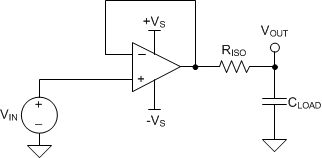SBOS556D June 2011 – August 2020 OPA171-Q1 , OPA2171-Q1 , OPA4171-Q1
PRODUCTION DATA
- 1 Features
- 2 Applications
- 3 Description
- 4 Revision History
- 5 Pin Configuration and Functions
- 6 Specifications
- 7 Detailed Description
- 8 Application and Implementation
- 9 Power Supply Recommendations
- 10Layout
- 11Device and Documentation Support
- 12Mechanical, Packaging, and Orderable Information
Package Options
Mechanical Data (Package|Pins)
Thermal pad, mechanical data (Package|Pins)
Orderable Information
8.2.1 Capacitive Load Drive Solution Using an Isolation Resistor
The OPAx171-Q1 device can be used capacitive loads such as cable shields, reference buffers, MOSFET gates, and diodes. The circuit uses an isolation resistor (RISO) to stabilize the output of an op amp. RISO modifies the open loop gain of the system to ensure the circuit has sufficient phase margin.
 Figure 8-2 Unity-Gain Buffer with RISO Stability Compensation
Figure 8-2 Unity-Gain Buffer with RISO Stability Compensation